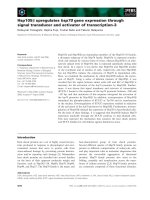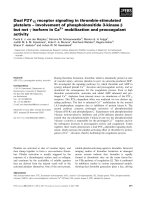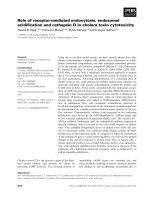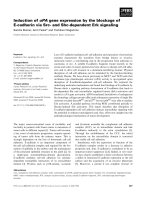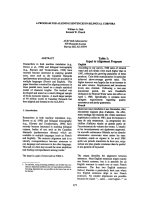Báo cáo khoa hoc:" Vitamin D receptor gene polymorphisms in multiple sclerosis patients in northwest Greece" docx
Bạn đang xem bản rút gọn của tài liệu. Xem và tải ngay bản đầy đủ của tài liệu tại đây (234.69 KB, 5 trang )
RESEARC H Open Access
Vitamin D receptor gene polymorphisms in
multiple sclerosis patients in northwest Greece
Chrissa Sioka
1*
, Stylianos Papakonstantinou
2,3
, Sofia Markoula
2
, Foteini Gkartziou
4
, Athanasia Georgiou
1
,
Ioannis Georgiou
4
, Sygliti-Henrietta Pelidou
2,3
, Athanassios P Kyritsis
2,3
and Andreas Fotopoulos
1
Abstract
Background: Polymorphisms of the vitamin D receptor (VDR) gene have been linked to both multiple sclerosis
(MS) and osteoporosis. We examined the frequency of the Taq-I and Bsm-I polymorphisms of the vitamin D
receptor (VDR) gene in 69 patients with MS and 81 age and sex-matched healthy individuals. Genotyping of Taq-I
(rs731236) and Bsm-I (rs1544410) was performed using TaqMan
®
SNP Genotyping Assay. All patients and controls
had determination of body mass index (BMI), bone mineral density (BMD) and smoking history.
Results: The mean age of patients was 39 ± 10.5 years compared to 38.7 ± 10.7 years of the controls (p = 0.86),
the BMI was 24.8 ± 4.2 kg/m
2
compared to 25.7 ± 4.8 kg/m
2
of the controls (p = 0.23), the BMD in the lumbar
spine 0.981 ± 0.15 compared to 1.025 ± 013 of the controls (p = 0.06) and the total hip BMD was 0.875 ± 0.14
compared to 0.969 ± 0.12 of the controls (p < 0.001). There were no differences of the Taq-I (TT, CT, CC) and Bsm-I
genotypes (GG, GA, AA) and allelic frequencies between MS and control individuals. Multivariate analysis also failed
to show any association of the Taq-I and Bsm-I polymorphisms and MS or sex, BMI, BMD and smoking history.
Conclusions: This study suggests that the Taq-I and Bsm-I polymorphisms of the VDR gene are not associated
with MS risk, BMI or BMD in the Greek population studied.
Background
Multiple sclerosis (MS) is a progressive demyelinating dis-
ease of the central nervous s ystem (CNS) that occurs
mainly in young adults, frequently leading to substantial
disability several years after diagnosis [1]. Vitamin D is
essential for bone and m ineral homeostasis and exhibits
immunoregulatory and anti-inflammatory properties [2].
Abnormal regulation of vitamin D metabolism has been
linked to MS and other diseases such as type 1 diabetes,
cancer, and osteoporosis [3-7]. Vitamin D acts through
the vitamin D receptor (VDR) and the membrane asso-
ciated rapid response steroid binding receptor (MARRS)
[8]. Certain polymorphisms of the VDR gene may modify
vitamin D function and metabolism and have been exam-
ined in studies evaluating the role of vitamin D on MS [9].
Several such studies that have investigated the role of
VDR gene polymorphisms in various ethnic groups have
produced conflicting results. A Japanese study reported
an association between the Bsm-I VDR gene allelic poly-
morphism and MS [10]. An Australian MS case-control
study found a significant difference of the Taq-I poly-
morphism genotype distribution in MS patients [11].
Similar results were reported in other studies [12].
Nevertheless, other studies found no differences of a
number of VDR gene polymorphisms between MS and
control groups [13-15]. However, these as well as other
studies reported other associations of the VDR gene poly-
morphisms, such as a significant interaction between
winter sun exposure during childhood [13], or interaction
between dietary intake of vitamin D and VDR gene poly-
morphisms on MS risk [16], and involvement of the Fok-
I VDR gene polymorphism in vitamin D metabolism [14].
In the present study we investigated the Taq-I and Bsm-I
polymorphisms of the VDR gene in a cohort of MS
patients and a control group in Northwest Greece.
Methods
Patients
The individuals recruited in this study were 69 consecu-
tive MS patients referred to the Nuclear Medicine
* Correspondence:
1
Department of Nuclear Medicine, University Hospital of Ioannina, Ioannina,
Greece
Full list of author information is available at the end of the article
Sioka et al. Journal of Negative Results in BioMedicine 2011, 10:3
/>© 2011 Sioka et al; licensee BioMed Central Ltd. This is an Open Access article distributed under the terms of the Creative Commons
Attribution License ( which permits unrestricted use, distribution, and reproduction in
any medium, provided the original work is properly cited.
Department for spinal and femoral BMD me asurements,
as part of a screening program of all MS patients for
osteopenia or osteoporosis, and 81 control individuals
matched for sex and age. All patients satisfied the Mc
Donald criteria for MS diagnosis [17]. None of the case
and c ontrol individuals were receiving chronica lly ster-
oids, bisphosphonates or selective estrogen receptor
modulators. Control individuals consisted of non-family
visitors to hospitalized patients in the neurology and
nuclear medicine services. Patients and control subjects
with a current or past medical condition or medication
use that may influence bone mineral metabolism
(hyperthyroidism, rheumatoid arthritis, hormone repla-
cement therapy, use of oral contraceptives for a period
longer that six months, past or recent use of hormone
therapy, etc.) were excluded from t he study. Patients
and contro ls were asked to give 10 ml of blood for the
study and they signed informed consent for testing. The
research protocol and consent form was approved by
the University Hospital of Ioannina Human Research
Committee.
Scanning
DXA scanning was performed utilizing a Hologic
Discovery W scanner (Hologic, Bedford, MA, United
States). All subjects had DXA scans performed in both
lumbar spine (L1-L4) and left total hip in supine posi-
tion. The scans and data analysis were performed by the
same technician. For data analysis, a software package
(v. 12.3:7, Hologic, Bedford, MA, United States) was
employed as directed by the manufacturer. The me a-
surements included the area of the examined bone, the
bone mineral content (BMC) and the BMD of each
anatomical site.
Genotyping of Taq-I and Bsm-I polymorphisms
All molecular genetic studies were performed in the
Laboratory of Medical Genetics in the Medical School
of the University of Ioannina blinded to case control
status. Genotyping of Taq-I (rs731236) and Bsm-I
(rs1 544410) was performed using TaqMan
®
SNP Geno-
typing Assay which consists of a predesigned mix of
unlabeled polymerase chain reaction (PCR) primers and
the TaqMan
®
minor gr oove binding group (MGB)
probe (FAM™ and VIC
®
dye-labeled). All TaqMan SNP
Genotyping Assays are designed to work with TaqMan
®
Universal PCR MasterMix which contains DNA poly-
merase, dNTPs and optimized mix components and
uses the same thermal conditions. These assays were
purchased from ABI (Applied Biosystems), and they
were applied using a Real Time PCR Rotor-Gene
RG3000 thermocycler (Corbett). The Taq1 T/C poly-
morphism is located in exon 9 that results in a Ile ® Ile
substitution for a sile nt codon change. It was genotyped
using Real-Time PCR in which one probe labeled with
VIC
®
detects the T allele and the other probe labeled
with FAM™ detects the C allele. Similarly, the Bsm1
G/A polymorphism at position 10,583,292 of the chro-
mosomal region 12q12-q14 is located in the intron
between exons 8 and 9 and is without consequences for
the VDR protein structure. This SNP genotyped using
VIC
®
labeled probe for the G allele detection and
FAM™ labeled probe for A allele detection, correspond-
ingly. Real Time PCR was performed using 7.5 μl
TaqMan
®
Genotyping Master Mix (2×), 0.75 μl
TaqMan
®
SNP Genotyping Assay (TaqMan probes)
(20×), 5.75 μl Dnase Free Water and 1 μlDNA
(1-10 ng), to bring the final reaction volume to 15 μl.
The Real Time PCR thermal conditions were as follows:
Initial d enaturing at 95°C f or 10 min; 40 cycles of 96°C
for 15 sec (denaturing) and 60°C for 1 min (annealing/
extension). Samples were run in duplicates, with posi-
tive, negative controls and blanks. All materials were
used in the TaqMan
®
SNP Genotyping Assay (ABI) in
accordance with the manufact urer’s instructions and the
information on the Applied Biosystems web site http://
www.appliedbiosystems.com.
Statistical analysis
Continuous data are presented as mean (standard devia-
tion), categorical data as percentages. For comparisons
of mean values between patients and controls statistical
analysis was performed by the independent samples
t-test. Categorical data was compare d using comparison
of two proportions (two-sided). Stepwise multiple
regression analysis was performed to examine factors
independently associated with the Taq-I and Bsm-I
polymorphisms of the VDR gene. Gender, age, body
mass index (BMI), MS diagnosis versus controls, smok-
ing duration and lumbar spine/total hip BMD were
included in the model as independent variables. P < =
0.05 was considered as statistically significant. The soft-
ware used for the statistical analysis was STATISTICA
(Stat Soft, Tulsa, OK).
Results
The phy sical characteristics of the MS patients and con-
trol group are shown in Table 1. The characteristics are
shown separately for females and males. The various
parameters that were recorded include mean age, BMI,
smoking years, BMD and expanded disability scale score
(EDSS) and MS type for the patients.
The genotypic and allelic frequencies of the Taq-I
(T > C) and Bsm-I (G > A) polymorphisms of the VDR
gene are depicted in table 2. No statistically significant
differences in the proportions of either polymorphism
or allelic frequencies were found between the patient
and the control groups. When the genotypic and allelic
Sioka et al. Journal of Negative Results in BioMedicine 2011, 10:3
/>Page 2 of 5
frequencies were compared between each MS subtype
patient group (relapsing-remitting MS, secondary
progressive MS and primary progress ive MS) and con-
trol individuals, no statistically differences were observed
as well (data not shown).
Among the various parameters examined, statistically
significant differences were found only in hip BMD
between patients and control groups (Table 3). There
was also a trend for lower BMD in the lumbar spine of
the patients compared to controls but the result did not
reach statistical significance (p = 0.06).
Multiple linear regression analysis of the Taq-I and
Bsm-I genotypic frequencies showed independence from
MS diagnosis versus c ontrols, age, sex, smoking history,
BMI, and lumbar spine or hip BMD (Table 4).
Discussion
In the present prospective study, we examined the Taq-I
and Bsm-I common polymorphisms of the VDR gene,
near its 3’ untranslated region. Although these poly-
morphisms do not result in structural changes of the
VDR protein, linkage disequilibrium with variation in
the 3 ’ untranslated region of the VDR ge ne may result
in alt ered protein expression [18]. Our results showed
no association between the Taq-I and Bsm-I polymorph-
isms of the VDR gene between the 69 MS patients and
81 control individuals, independently of the MS type.
Previous studies have shown either correlation or no
association suggesting ethnic or regional differenc es
[1,9]. For example, a Japanese group reported in 77
patients and 95 controls an overrepresentation of the
Bsm-I G allele and homozygote GG in MS patients and
in addition higher frequency of the Apa-I AA genotype
and A allele in MS [10,19]. Similarly, an Australian
case-control study in 104 MS patients and 104 controls,
found a significant difference of genotype distribution
between the case and control groups for the Taq-I poly-
morphism and the allelic frequency [11]. Partridge et al.
in 419 cases and 422 controls described reduced
Table 1 Physical characteristics of the MS patients (females and males) and control group [mean value ± standard
deviation (range)]
Females Males
Characteristics n MS Patients (46) Controls (58) MS Patients (23) Controls (23)
Mean age (years) 38.5 ± 9.9 (21-58) 38.6 ± 10.8 (20-60) 39.5 ± 11.8 (21-60) 38.8 ± 10.5 (23-60)
BMI (kg/m
2
) 24.9 ± 4.6 (16.8-34) 24.9 ± 5.1 (18.5-45.7) 25.1 ± 3.7 (17.4-36.4) 27.6 ± 3.2 (21.2-31.9)
Smoking period (years) 9.1 ± 10.8 (0-39) 8 ± 9.8 (0-33) 17 ± 12.4 (0-44) 12.4 ± 12.3 (0-38)
BMD (LS) 0.996 ± 0.16 (0.675-1.329) 1.025 ± 0.135 (0.738-1.29) 0.956 ± 0.12 (0.774-1.215) 1.028 ± 0.13 (0.71-1.26)
BMD (Hip) 0.857 ± 0.14 (0.542-1.132) 0.947 ± 0.123 (0.661-1.244) 0.915 ± 0.14 (0.615-1.286) 1.022 ± 0.1 (0.745-1.191)
EDSS 1.5 ± 1.8 (0 -5.5) 2.76 ± 2.5 (0 - 8)
MS type RRMS = 32 RRMS = 15
SPMS = 13 SPMS = 7
PPMS = 1 PPMS = 1
MS: Multiple sclerosis; BMI: body mass index; EDSS: Expanded disability scale score; BMD: Bone mineral density; LS: Lumbar spine.
Hip: Total hip area; RRMS: Rela psing-remitting MS; SPMS: Secondary progressive MS; PPMS: Primary progre ssive MS.
Table 2 Comparison between MS patients and control
individuals of the Taq-I (T > C) and Bsm-I (G > A)
polymorphisms of the VDR gene
Enzyme analysis n Patients (69) Controls (81) p
Taq-I polymorphism
Genotype
TT 30 (43.5%) 33 (44.8%) 0.91
CT 30 (43.5%) 36 (44.4%) 0.94
CC 9 (13%) 12 (14.8%) 0.9
Allele
T 65.2% 63% 0.78
C 34.8% 37% 0.80
Bsm-I polymorphism
Genotype
GG 28 (40%) 26 (32%) 0.54
GA 41 (60%) 55 (68%) 0.42
AA 0 0
Allele
G 70% 66% 0.60
A 30% 34% 0.6
MS: Multiple sclerosis; VDR: Vitamin D receptor.
Table 3 Comparison of various parameters between MS
patients and control individuals
Factor Patients Controls p
Sex 46 Female 58 Female
23 Male 23 Male
Mean age (years) 39.0 ± 10.5 38.7 ± 10.7 0.86
BMI (kg/m
2
) 24.8 ± 4.2 25.7 ± 4.8 0.23
Smoking period (years) 11.9 ± 11.8 9.3 ± 10.7 0.18
BMD (LS) 0.981 ± 0.15 1.025 ± 0.13 0.06
BMD (Hip) 0.875 ± 0.14 0.969 ± 0.12 <0.001*
BMI: body mass index; BMD: Bone mineral density; LS: Lumbar spine; Hip:
Total hip area.
*: Statistically significant.
Sioka et al. Journal of Negative Results in BioMedicine 2011, 10:3
/>Page 3 of 5
expression of the Fok-I ff VDR genotype in MS patients
[12]. It is interesting that the above studies that reported
association of VDR gene polymorphisms and MS,
involved populations with possibly high exposure to
vitamin D either due to increased sunlight or higher
intake.
Several large case-control studies have reported no
association of the common VDR gene polymorphisms
and MS risk. Thus, a US study in 214 MS cases and 428
age-matched controls found no associations for any of
the single-nucleotide polymorphisms in VDR, but found
an interaction between dietary intake of vitamin D and
the VDR Fok-I polymorphism on MS risk. Specifically,
individuals with the ff genotype had decreased MS risk
with higher vitamin D intake [16]. Negative results have
bee n reported in a Canadian study employed restriction
fragment length polymorphisms and highly polymorphic
microsatellite markers to study VDR gene polymorph-
isms and MS risk [15]. Α recent study in 136 MS cases
and 235 controls showed no significant associations
between the polymorphisms Cdx-2, Fok-I, or Taq-I and
MS risk, b ut there was a significant correlation between
winter sun exposure during childho od, the gen otype at
Cdx-2, and MS risk [13]. In that study the G allele was
associated with increased risk of MS in the low sun
exposure group (≤2 hours per day), indicating that an
interaction of the VDR gene polymorphisms and MS
maybedependentonpastsunexposure[13].Another
study in 212 MS patients and 289 controls found no
association of Apa-I and Taq-I VDR gene polymorph-
isms with the serum levels of 25(OH)D and 1,25(OH)(2)
D, and MS risk [20]. A further study in the same cohort
of patients, although failed to find any association of the
Fok-I VDR gene polymorphism with MS, reported that
the f-allele was associated with lower winter and sum-
mer serum 25(OH)D levels in MS pat ients and lower 25
(OH)D levels in healthy controls. In addition, the f-allele
car riers had higher 1,25(OH)(2)D/25(OH)D-ratios com-
pared to f-allele carriers, indicating a possible role of the
Fok-I VDR gene polymorphism in vitamin D metabo-
lism [14]. Thus, certain polymorphisms of the VDR
gene may have regulating effects on vitamin D function
and metabolism and may be associated with MS risk,
depending on previous or current vitamin D intake [9].
In the present study there was increased frequency of
low BMD in MS patients compared to controls, espe-
cially involving the hip area and to a lesser degree the
lumbar spine. Our results of low BMD in MS patients
are in accordance with previous studies that demon-
strated reduced BMD and i ncreased frequency of osteo-
porosis in MS associated with low vitamin D levels
[21,22]. However, the multivariate analysis failed to
show any dependence of the low BMD from the Taq-I
and Bsm-I polymorphisms of the VDR gene. Previous
studies have showed no evidence of association between
common polymo rphisms of the VDR gene and BMD in
British women [23], and between the Bsm-I VDR gene
polymorphism and osteoporosis in a Korean population
[24]. However, VDR gene polymorphisms have been
associated with Graves’ disease in a Japanese population
[25], and has been suggested that a Fok-I VDR gene
polymorphism may predict risk of osteoporosis in such
patients [26].
Conclusions
In summary, our findings showed no direct association
of the Taq-I and Bsm-I polymorphisms of the VDR
gene with either MS risk or bone mineral density in a
sample population of Northwest Greece. Future studies
should focus on the possible regulatory role of such
polymorphisms on vitamin D function and metabolism
and assess the MS risk depending on long term sunlight
exposure and vitamin D intake.
Acknowledgements
We wish to thank the president and patients of the “Union of Friends and
Patients with Multiple Sclerosis” (Ioannina, Greece) for their participation in
this study.
Funding
None
Author details
1
Department of Nuclear Medicine, University Hospital of Ioannina, Ioannina,
Greece.
2
Department of Neurology, University Hospital of Ioannina, Ioannina,
Greece.
3
Neurosurgical Research Institute, University of Ioannina, Ioannina,
Greece.
4
Laboratory of Medical Genetics, University Hospital of Ioannina,
Greece.
Authors’ contributions
CS conceived of the study, participated in its design and wrote the
manuscript. SP participated in the design of the study and in clinical data
collection. SM participated in clinical data collection and the molecular
genetic assays. FG performed the PCR assays for determination of the VDR
polymorphisms. AG participated in the blood selection and determination of
the BMD using DXA. IG participated in the design of the study, the genetic
statistics and manuscript writing. SHP participated in the clinical data
collection and study design. APK participated in the design of the study,
data collection and coordination during writing of the manuscript. AF was
Table 4 Multiple linear regression analysis. Dependent
variables Taq-I and Bsm-I (69 MS patients and 81
controls)
Taq-I Bsm-I
Independent variable Beta p Beta p
MS versus controls 0.05 0.95 -0.04 0.62
Sex -0.70 0.44 0.07 0.44
Age -0.40 0.7 -0.11 0.32
BMI 0.05 0.63 0.00 0.99
Smoking years 0.12 0.19 -0.07 0.40
BMD (LS) 0.05 0.69 0.00 0.99
BMD (Hip) -0.27 0.12 -0.29 0.20
BMD: bone mineral density; BMI: body mass index; MS: Multiple scl erosis; LS:
Lumbar spine
Sioka et al. Journal of Negative Results in BioMedicine 2011, 10:3
/>Page 4 of 5
responsible for the BMD determination using DXA in the laboratory of
nuclear medicine and overview of the study. All authors read and approved
the final manuscript.
Competing interests
The authors declare that they have no competing interests.
Received: 5 October 2010 Accepted: 5 May 2011 Published: 5 May 2011
References
1. Sioka C, Kyritsis AP, Fotopoulos A: Multiple sclerosis, osteoporosis, and
vitamin D. J Neurol Sci 2009, 287:1-6.
2. Adorini L, Penna G: Control of autoimmune diseases by the vitamin D
endocrine system. Nat Clin Pract Rheumatol 2008, 4:404-412.
3. Alpert PT, Shaikh U: The effects of vitamin D deficiency and insufficiency
on the endocrine and paracrine systems. Biol Res Nurs 2007, 9:117-129.
4. Holick MF: The vitamin D epidemic and its health consequences. J Nutr
2005, 135:2739S-2748S.
5. Lips P: Vitamin D physiology. Prog Biophys Mol Biol 2006, 92:4-8.
6. Peterlik M, Cross HS: Vitamin D and calcium deficits predispose for
multiple chronic diseases. Eur J Clin Invest 2005, 35:290-304.
7. Peterlik M, Cross HS: Dysfunction of the vitamin D endocrine system as
common cause for multiple malignant and other chronic diseases.
Anticancer Res 2006, 26:2581-2588.
8. Fernandes de Abreu DA, Eyles D, Feron F: Vitamin D, a neuro-
immunomodulator: implications for neurodegenerative and
autoimmune diseases. Psychoneuroendocrinology 2009, 34(Suppl 1):
S265-277.
9. Smolders J, Peelen E, Thewissen M, Menheere P, Cohen Tervaert JW,
Hupperts R, Damoiseaux J: The relevance of vitamin D receptor gene
polymorphisms for vitamin D research in multiple sclerosis. Autoimmun
Rev 2009, 8:621-626.
10. Fukazawa T, Yabe I, Kikuchi S, Sasaki H, Hamada T, Miyasaka K, Tashiro K:
Association of vitamin D receptor gene polymorphism with multiple
sclerosis in Japanese. J Neurol Sci 1999, 166:47-52.
11. Tajouri L, Ovcaric M, Curtain R, Johnson MP, Griffiths LR, Csurhes P,
Pender MP, Lea RA: Variation in the vitamin D receptor gene is
associated with multiple sclerosis in an Australian population. J
Neurogenet 2005, 19:25-38.
12. Partridge JM, Weatherby SJ, Woolmore JA, Highland DJ, Fryer AA, Mann CL,
Boggild MD, Ollier WE, Strange RC, Hawkins CP: Susceptibility and
outcome in MS: associations with polymorphisms in pigmentation-
related genes. Neurology 2004, 62:2323-2325.
13. Dickinson JL, Perera DI, van der Mei AF, Ponsonby AL, Polanowski AM,
Thomson RJ, Taylor BV, McKay JD, Stankovich J, Dwyer T: Past
environmental sun exposure and risk of multiple sclerosis: a role for the
Cdx-2 Vitamin D receptor variant in this interaction. Mult Scler 2009,
15:563-570.
14. Smolders J, Damoiseaux J, Menheere P, Tervaert JW, Hupperts R: Fok-I
vitamin D receptor gene polymorphism (rs10735810) and vitamin D
metabolism in multiple sclerosis. J Neuroimmunol 2009,
207:117-121.
15. Steckley JL, Dyment DA, Sadovnick AD, Risch N, Hayes C, Ebers GC: Genetic
analysis of vitamin D related genes in Canadian multiple sclerosis
patients. Canadian Collaborative Study Group. Neurology 2000,
54:729-732.
16. Simon KC, Munger KL, Xing Y, Ascherio A: Polymorphisms in vitamin D
metabolism related genes and risk of multiple sclerosis. Mult Scler
16:133-138.
17. McDonald WI, Compston A, Edan G, Goodkin D, Hartung HP, Lublin FD,
McFarland HF, Paty DW, Polman CH, Reingold SC, Sandberg-Wollheim M,
Sibley W, Thompson A, van den Noort S, Weinshenker BY, Wolinsky JS:
Recommended diagnostic criteria for multiple sclerosis: guidelines from
the International Panel on the diagnosis of multiple sclerosis. Ann Neurol
2001, 50:121-127.
18. Ingles SA, Haile RW, Henderson BE, Kolonel LN, Nakaichi G, Shi CY, Yu MC,
Ross RK, Coetzee GA: Strength of linkage disequilibrium between two
vitamin D receptor markers in five ethnic groups: implications for
association studies. Cancer Epidemiol Biomarkers Prev 1997, 6:93-98.
19. Niino M, Fukazawa T, Yabe I, Kikuchi S, Sasaki H, Tashiro K: Vitamin D
receptor gene polymorphism in multiple sclerosis and the association
with HLA class II alleles. J Neurol Sci 2000, 177:65-71.
20. Smolders J, Damoiseaux J, Menheere P, Tervaert JW, Hupperts R:
Association study on two vitamin D receptor gene polymorphisms and
vitamin D metabolites in multiple sclerosis. Ann N Y Acad Sci 2009,
1173:515-520.
21. Nieves J, Cosman F, Herbert J, Shen V, Lindsay R: High prevalence of
vitamin D deficiency and reduced bone mass in multiple sclerosis.
Neurology 1994, 44:1687-1692.
22. Ozgocmen S, Bulut S, Ilhan N, Gulkesen A, Ardicoglu O, Ozkan Y: Vitamin D
deficiency and reduced bone mineral density in multiple sclerosis: effect
of ambulatory status and functional capacity. J Bone Miner Metab 2005,
23:309-313.
23. Macdonald HM, McGuigan FE, Stewart A, Black AJ, Fraser WD, Ralston S,
Reid DM: Large-scale population-based study shows no evidence of
association between common polymorphism of the VDR gene and BMD
in British women. J Bone Miner Res 2006, 21:151-162.
24. Lim SK, Park YS, Park JM, Song YD, Lee EJ, Kim KR, Lee HC, Huh KB: Lack of
association between vitamin D receptor genotypes and osteoporosis in
Koreans. J Clin Endocrinol Metab 1995, 80:3677-3681.
25. Ban Y, Taniyama M: Vitamin D receptor gene polymorphism is associated
with Graves’ disease in the Japanese population. J Clin Endocrinol Metab
2000, 85:4639-4643.
26. Ban Y, Taniyama M, Katagiri T: Vitamin D receptor initiation codon
polymorphism in Japanese patients with Graves’ disease. Thyroid 2000,
10:475-480.
doi:10.1186/1477-5751-10-3
Cite this article as: Sioka et al.: Vitamin D receptor gene polymorphisms
in multiple sclerosis patients in northwest Greece. Journal of Negative
Results in BioMedicine 2011 10:3.
Submit your next manuscript to BioMed Central
and take full advantage of:
• Convenient online submission
• Thorough peer review
• No space constraints or color figure charges
• Immediate publication on acceptance
• Inclusion in PubMed, CAS, Scopus and Google Scholar
• Research which is freely available for redistribution
Submit your manuscript at
www.biomedcentral.com/submit
Sioka et al. Journal of Negative Results in BioMedicine 2011, 10:3
/>Page 5 of 5

